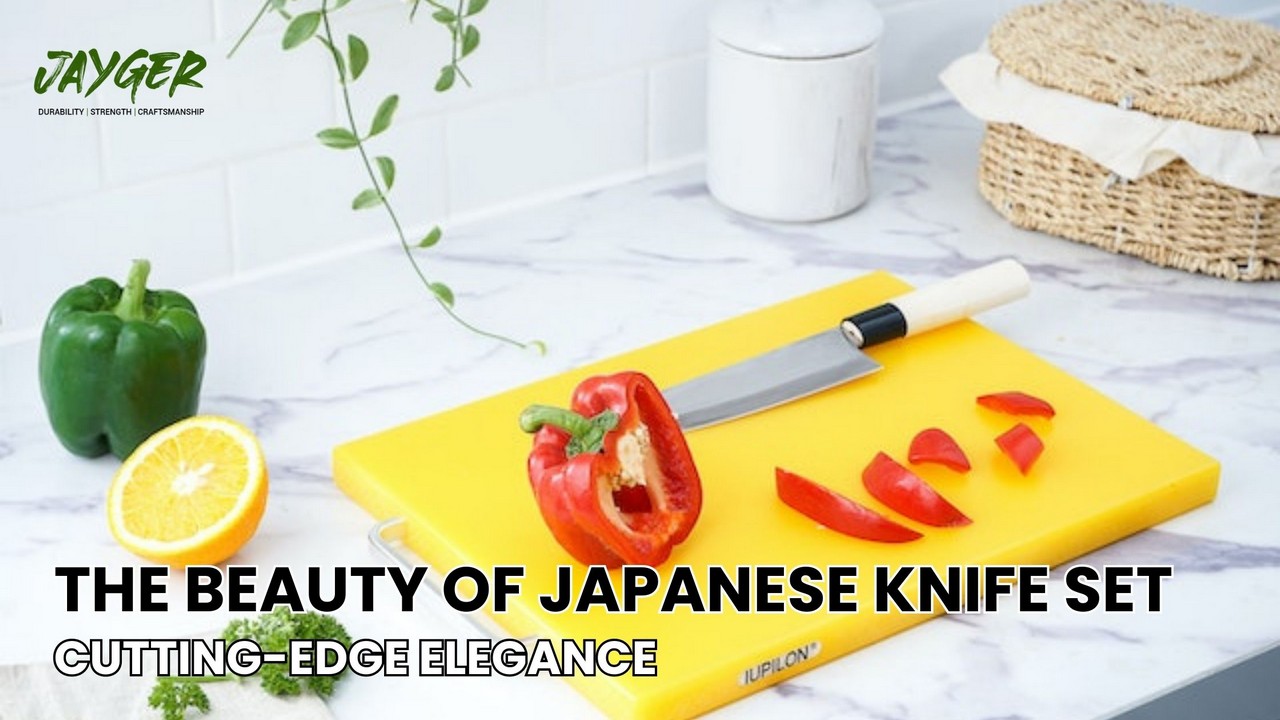Blog
Cutting-Edge Elegance: The Beauty of Japanese Knife Sets

Indulge your senses in exquisite craftsmanship and culinary artistry with Japanese knife sets. Renowned for their precision and unparalleled elegance, these cutting-edge tools have become a staple in professional kitchens and cooking enthusiasts’ homes. From the intricate forging techniques to the meticulous attention to detail, every aspect of a Japanese knife set is a testament to the centuries-old tradition and passion for perfection. Handcrafted by skilled artisans using time-honored methods, the blades boast a remarkable sharpness that effortlessly glides through ingredients, ensuring precision and control like no other. But it’s not just their functionality that sets them apart; the beauty of Japanese knife sets lies in their harmonious blend of form and function.
The graceful curves of the blades and the intricately designed handles create a visual feast, elevating your culinary experience to new heights. Whether you’re a professional chef or an aspiring home cook, embracing the allure of Japanese knife sets will undoubtedly enhance your culinary journey and leave you in awe of their cutting-edge elegance.
History and Tradition of Japanese Knives
Japanese knives have a rich history that dates back centuries. The art of knife-making in Japan can be traced back to the Heian period, around the 8th century. During this time, swordsmiths began using their skills to create knives for everyday use. These early knives were made from simple materials and needed more sophistication than modern Japanese knives.
Over time, the craft of knife-making in Japan evolved, and distinct regional styles emerged. Each region had unique techniques and traditions, resulting in a diverse range of knife styles. Today, some of Japan’s most famous regions for knife-making include Sakai, Seki, and Tosa.
Types of Japanese Knives and Their Uses
Japanese knives come in various shapes and sizes, each designed for a specific purpose. Here are some of the most common types of Japanese knives:
Gyuto: The Gyuto knife is the Japanese equivalent of a Western chef’s knife. It has a long, thin blade with a slight curvature, making it ideal for slicing, dicing, and chopping a wide range of ingredients.
Santoku: The Santoku knife is a versatile all-purpose knife that excels at slicing, dicing, and mincing. It features a shorter, wider blade with a flat edge and a sheepsfoot tip.
Deba: The Deba knife is a heavy, thick-bladed knife primarily used for fileting and butchering fish. Its sturdy construction allows clean, precise cuts through the bones and tough skin.
Yanagiba: The Yanagiba knife is a long, single-beveled knife for slicing raw fish and seafood. Its thin, sharp blade glides effortlessly through delicate ingredients, ensuring clean cuts without tearing.
Benefits of Using Japanese Knife Sets
There are several benefits to using Japanese knife sets that set them apart from their Western counterparts. One of the main advantages is their exceptional sharpness. Japanese knives are known for their incredible edge retention and ability to maintain sharpness over extended periods.
The meticulous craftsmanship that goes into making Japanese knives also contributes to their superior performance. Each knife is hand-forged by skilled artisans who have spent years honing their craft. This level of attention to detail ensures that every knife is a work of art and a highly functional tool.
Another benefit of using best Japanese knife is their ergonomic design. Japanese knives are carefully balanced to provide optimal control and comfort during use. The handles are typically made from natural materials such as wood, which adds to the overall aesthetic appeal of the knives.
The Role of High-Quality Steel in Japanese Knife Craftsmanship
The choice of steel is a crucial factor in the craftsmanship of Japanese knives. The high-quality steel used in Japanese knives is known for its exceptional hardness, toughness, and edge retention. One of the most common types of steel used is “Hagane,” a combination of high-carbon steel and low-carbon iron.
Forging Japanese knives involves heating and hammering the steel to shape the blade. This process gives the blade its distinctive shape and enhances its strength and durability. Repeated heating and hammering also help to align the steel’s crystalline structure, resulting in a sharp and resilient blade.
What Makes Japanese Knife Sets Stand Out in the Culinary World?
Japanese knife sets have gained worldwide recognition for their exceptional quality and performance. One key factor that sets them apart is the meticulous attention to detail that goes into their crafting. The artisans who make Japanese knives undergo years of rigorous training to master their craft, ensuring that every knife is a masterpiece in its own right.
Another distinguishing feature of Japanese knife sets is their unique blade geometry. Japanese knives typically have a thinner, finer edge than their Western counterparts. This allows for more precise cuts and reduces the amount of food sticking to the blade, making for a smoother and more enjoyable cutting experience.
The beauty of Japanese knife sets lies not only in their functionality but also in their aesthetic appeal. The blades, with their graceful curves and stunning patterns, are a testament to the artistry and skill of the artisans who create them. Often adorned with intricate designs, the handles add another layer of visual delight.
Care and Maintenance of Japanese Knives
Proper care and maintenance are essential to ensure the longevity and performance of your Japanese knife set. Here are some tips to keep your knives in top condition:
Hand-washing: Japanese knives should always be hand-washed with warm, soapy water and dried immediately after use. Avoid soaking them in water or putting them in the dishwasher, as this can cause damage to the blades and handles.
Sharpening: Regular sharpening is necessary to maintain the sharpness of your Japanese knives. Use a whetstone or sharpening rod designed explicitly for Japanese knives to keep the blades in optimal condition.
Storage: Store your Japanese knives in a knife block or magnetic strip to protect the blades and keep them sharp. Avoid storing them in a drawer where they can get damaged or dull.
Japanese Knife Set Accessories and Extras
In addition to the knives themselves, some several accessories and extras can enhance your Japanese knife set:
Knife sharpener: A high-quality knife sharpener is essential for maintaining the edge of your Japanese knives. Look for a sharpener specifically designed for Japanese knives to ensure optimal results.
Knife block: A stylish knife block keeps your knives organized and protects them from damage. Choose a block that fits your knife set and complements your kitchen decor.
Knife bag or roll: If you’re a professional chef or frequently travel with your knives, a knife bag or roll is a convenient way to transport and protect your Japanese knife set. Look for one with secure compartments and durable construction.
Embrace the allure of Japanese knife sets and elevate your culinary journey to new heights. With their unrivaled sharpness, exquisite craftsmanship, and timeless beauty, these cutting-edge tools are a testament to the artistry and passion of their makers. Whether you’re a professional chef or an aspiring home cook, investing in a Japanese knife set is a decision that will enhance your cooking experience and leave you in awe of its unparalleled elegance.
